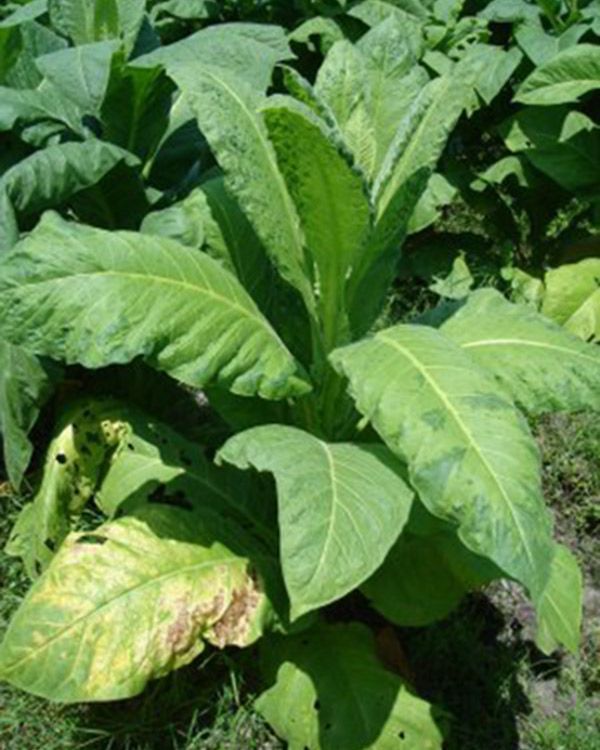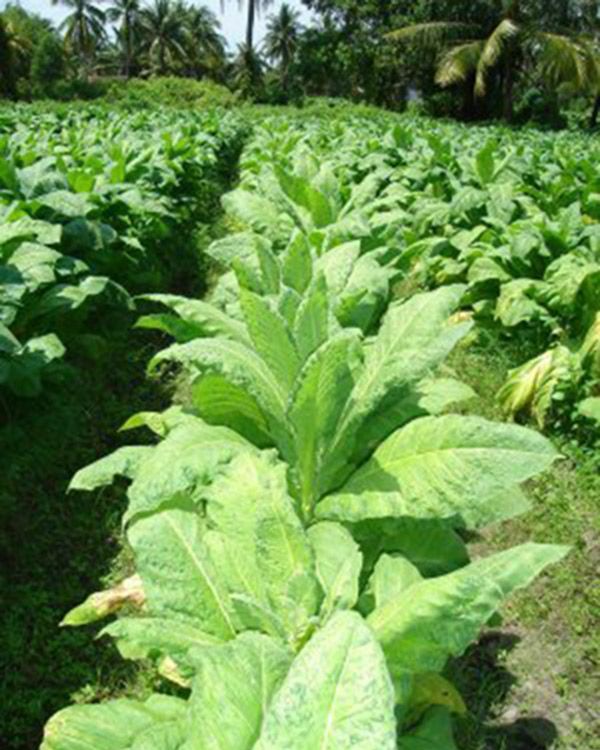Diseases and Pests
Tobacco Mosaic Virus - TMV
The first symptom of this virus is a light green coloration between the veins of young leaves, followed by a mosaic that alternates the coloration of light and dark green areas on the leaves. Mosaic does not result in plant death, but if it occurs early in the season, plants are stunted and growth is retarded. What also occurs is “mosaic burn” to the lower leaves, especially during hot and dry climate spells. Symptoms may vary from light spots to crinkled leaves, and are sometimes taken for other virus diseases like CMV or PVY. Plants subject to some kind of stress or growth difficulty, both symptoms and damages look more serious.
The virus is transmitted mechanically, from plant to plant, or through contact, where man is the main spreader. For this reason, frequently, there is a bigger number of TMV-infected plants in some rows, where transmission occurred during planting or cultivation practices.
The virus can live in the soil for long periods of time, normally in the roots, crop remains or other host plants. After infection, there is no cure or remedy against this virus disease, which prompts the need for preventive measures. The best technique to avoid TMV infestations is the use of resistant cultivars.
In the case of susceptible cultivars, when there are small numbers of infected plants in the field, these should be removed in order to prevent the disease from spreading. When growers have more than one field, and one of them is infected, all cultivation practices should always start in the healthy fields, and then progress to the infected areas.
The Tobacco mosaic virus was once the most serious tobacco disease, but its economic importance diminished with the availability and use of resistant cultivars.
There are several good quality and high yield cultivars, resistant to TMV, released by ProfiGen.
Symptom disease pictures:
See also
-
Diseases and Pests
- Cucumber Mosaic Virus - CMV
- Nematodes
- Potato Virus Y - PVY
- Yellow Stunt
- Diseases and Pests
- Bacterial Wilt
- Tobacco Mosaic Virus - TMV
- Curly top - BCTV
- Tomato Spotted Wilt Virus - TSWV
- Black Shank
Related products
-
NC100
PVY - Resistant
-
PVH03
TMV - Resistant
-
PVH09
Bacterial wilt tolerant
-
PVH19
Early maturity
-
PVH2233
PVY - Resistant
-
PVH2241
TMV - Resistant
-
PVH2254
Bacterial wilt tolerant
-
PVH2259
Nematode - Resistant
-
PVH2261
PVY - Resistant
-
PVH2275
Nematode - Resistant
-
PVH2299
TMV - Resistant
-
PVH2306
Early maturity
-
PVH2310
Early maturity
-
PVH2324
Early maturity
-
PVH2340
Nematode - Resistant
-
PVH2343
Bacterial wilt tolerant
-
PVH2356
Nematode - Resistant
-
PVH2369
Nematode - Resistant
-
PVH2376
Nematode - Resistant
-
PVH2404
PVY - Resistant
-
PVH2408
Nematode - Resistant
-
PVH2411
TMV - Resistant
-
PVH2414
PVY - Resistant
-
PVH51
TMV - Resistant
-
HB4151P
Fusarium and Bacterial Wilt - Tolerant
-
HB4155P
Fusarium and Bacterial Wilt - Tolerant
-
HB4167P
Black Shank - Resistant
-
HB4180P
Fusarium and Bacterial Wilt - Tolerant
-
HB4192P
Black Shank - Resistant
-
HB4194P
Nematode - Resistant
-
HB4196P
Fusarium and Bacterial Wilt - Tolerant
-
HB4198P
Nematode - Resistant
-
HB4266P
Nematode - Resistant
-
HB4488P
Nematode - Resistant
-
KT204LC
Black Shank - Resistant
-
KT206LC
Black Shank - Resistant
-
KT209LC
Black Shank - Resistant
-
KT210LC
Black Shank - Resistant
-
KT212LC
Black Shank - Resistant
-
NC2002
Blue mold tolerant
-
NC4
Nematode - Resistant
-
PD7318LC
Dark Hybrids


